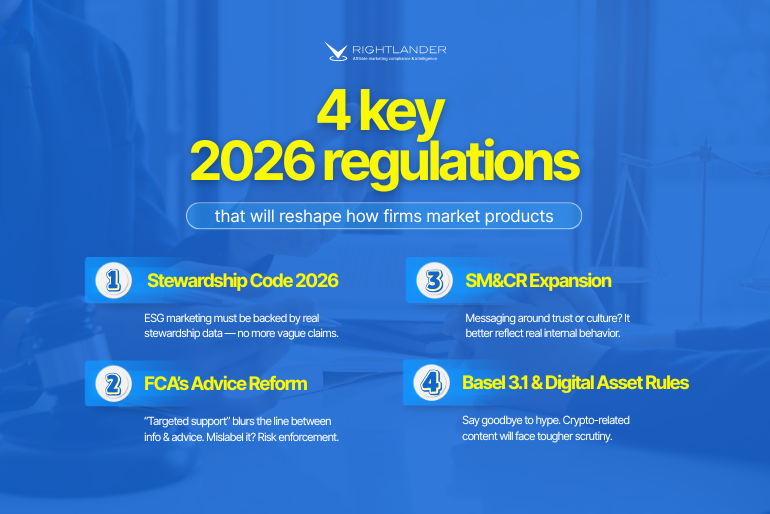As Q4 begins, most financial services firms are focused on performance — hitting growth targets, launching last-minute campaigns, and extracting every ounce of revenue from the calendar year. But beneath that urgency lies a quieter, more consequential clock: the countdown to 2026.
In just over a year, the compliance landscape for UK and global financial institutions will undergo some of the most significant changes since the Markets in Financial Instruments Directive II (MiFID II) was introduced. These reforms don’t just affect how firms operate; they fundamentally reshape how financial products can be marketed, promoted, and communicated to the public.
Here’s what’s coming:
Stewardship and the End of Environmental, Social & Governance Vagueness
From January 2026, the UK’s revised Stewardship Code takes effect, bringing ESG credibility into sharper focus. The new framework requires not only that asset managers and financial institutions disclose their stewardship policies, but also that they provide evidence of the outcomes.
For marketing teams, this is a shift from impression to substantiation. Vague sustainability slogans or blanket ESG claims — once tolerated — may soon fall on the wrong side of compliance.
Example: A wealth manager promoting a “green fund” will no longer be able to rely on generic statements like “we invest responsibly.” Instead, they’ll need to show how portfolio companies align with measurable ESG outcomes — such as reductions in carbon intensity or diversity metrics.
In Q4, don’t cut ESG messaging — strengthen its foundation. Every claim should be traceable to a policy, report, or public disclosure. Marketing compliance systems must be able to distinguish between opinion and regulated positioning and flag unsupported ESG language before it makes it to market.
Advice Reform: Walking a New Regulatory Tightrope
April 2026 will see the Financial Conduct Authority's (FCA’s much-anticipated reforms to the financial advice framework come into effect, enabling firms to offer “targeted support” and “simplified advice” to customers who might not qualify for — or be able to afford — traditional financial advice.
It’s a positive step for inclusion. But for marketers, it introduces ambiguity. Promotional content will now operate in a grey zone between generic education and personalised guidance.
For example, a bank running an educational campaign about retirement planning might unintentionally include phrases like “we recommend you…” or “you should move your pension…” — which could cross into regulated advice.
In this transitional Q4, compliance teams should begin reclassifying content types — making clear distinctions between “informational,” “supportive,” and “advisory” content. Automated marketing review systems that can detect advice-adjacent language will become vital tools, not just for legal protection, but for enabling firms to operate confidently in this new space.
Culture Is Compliance: Marketing Integrity
The extension of the Senior Managers & Certification Regime (SM&CR) to include non-financial misconduct, taking effect in September 2026, is often framed as an HR or legal issue. But it has clear implications for marketing and brand messaging, too.
Financial firms that promote values like integrity, inclusion, or accountability must now ensure that these aren’t just slogans.
Example: If a firm runs an advertising campaign built around “we put integrity first,” but internal reviews uncover misconduct or weak governance, regulators could view the campaign as misleading.
This is where marketing and compliance intersect in new, more profound ways. Campaigns that reference culture or ethics should be vetted not only for tone but for verifiability.
The End of Risky Crypto Marketing
Significant changes are coming for how banks and financial firms handle crypto — and it’s going to affect how you market it.
Starting in January 2026, new rules under Basel 3.1 will require firms to be much more cautious about how they manage and promote digital assets. That means tighter controls on what’s said in marketing about things like crypto, tokenised investments, and other high-risk products.
Phrases like “safe,” “guaranteed,” or “low risk” — which were once used freely in fintech campaigns — could soon land firms in hot water if they’re seen as misleading.
This is a wake-up call for marketing and compliance teams: it’s time to move beyond hype. Campaigns need to reflect the real level of risk, not just catchy copy.
If your firm is promoting digital asset products, Q4 is the moment to tighten up. Build in stricter reviews, rethink your messaging, and consider automated tools that scan for risky language before your content goes live.
The Q4 Opportunity: Future-Proofing Marketing at Speed
2026 may seem far off, but Q4 is your last clean window to prepare. By Q1 2026, campaign pipelines will already be built, and rewiring them for new regulatory demands will be costly, both in time and risk.
Now is the moment to modernise your marketing compliance workflows:
- Update review criteria to reflect upcoming regulatory changes
- Categorise content types based on regulatory sensitivity
- Automate campaign approvals with built-in language risk detection
- Train teams to flag ESG, advice, and governance language for enhanced scrutiny
The marketing leaders of 2026 won’t just be compliant. They’ll be fast, efficient, and trusted — because they started building toward that future now.
If you’d like to see how our platform helps marketing teams align content with evolving financial regulation, let’s connect.

 by Shenaly Amin | 05 Nov 2025
by Shenaly Amin | 05 Nov 2025
 4-min read
4-min read




